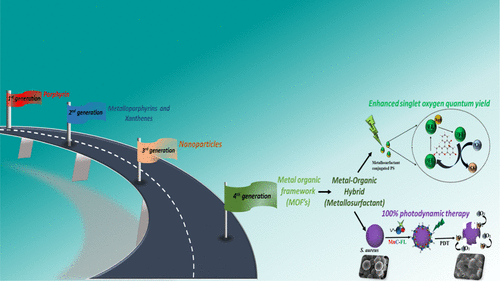当前位置:
X-MOL 学术
›
ACS Appl. Bio Mater.
›
论文详情
Our official English website, www.x-mol.net, welcomes your
feedback! (Note: you will need to create a separate account there.)
Fluorescein–Metal Hybrid Surfactant Conjugates as a Smart Material for Antimicrobial Photodynamic Therapy against Staphylococcus aureus
ACS Applied Bio Materials ( IF 4.6 ) Pub Date : 2020-06-16 , DOI: 10.1021/acsabm.0c00586 Preeti Garg 1 , Gurpreet Kaur 1 , Bunty Sharma 1 , Ganga Ram Chaudhary 1
ACS Applied Bio Materials ( IF 4.6 ) Pub Date : 2020-06-16 , DOI: 10.1021/acsabm.0c00586 Preeti Garg 1 , Gurpreet Kaur 1 , Bunty Sharma 1 , Ganga Ram Chaudhary 1
Affiliation

|
Photodynamic therapy (PDT) has been extensively used as an effective alternative for the treatment of bacterial infection using photosensitizers (PSs) in the presence of appropriate light. However, the limitation in the effectiveness of PDT is because of the low yield of singlet oxygen from existing PSs because of their low solubility. Thus, we have developed a platform to enhance the solubility and the photodynamic activity of PSs against bacterial cells using metallosurfactants. Herein, we have used manganese metal-containing single- (MnC I) and double-chain metallosurfactants (MnC II) which show an interplay of electrostatic/hydrophobic interactions with fluorescein (FL) dye (as a PS) and when used in the presence of light enhances the PDT. These interactions play a significant role in enhancing the singlet oxygen generation efficiency of FL. MnC I and MnC II have shown good antimicrobial activity against Gram-positive Staphylococcus aureus (S. aureus) bacteria. More interestingly, these metallosurfactants when combined with FL significantly enhanced the affectivity against S. aureus, wherein 100% killing was achieved. As compared to experiments performed in the dark, the metallosurfactant, by enhancing the solubility of FL, increases the formation of singlet oxygen upon light irradiation and thus increases cell death. Therefore, the synergistic effect of FL (light toxicity) and metallosurfactants (dark toxicity) defined excellent reduction in the colony formation of bacteria. These results were corroborated through field-emission scanning electron microscopy and optical microscopy, where the rupturing of the cell wall of bacterial cells was observed during this therapy. Moreover, the binding of metallosurfactants to the genomic DNA of S. aureus was also evaluated by gel retardation analysis and UV–visible spectroscopy. The outcomes from this study will deliver formulations for PDT which can be used in clinical medical applications and cancer therapy in the future.
中文翻译:

荧光素-金属混合表面活性剂偶联物作为抗金黄色葡萄球菌的抗菌光动力疗法的智能材料
光动力疗法 (PDT) 已被广泛用作在适当光存在下使用光敏剂 (PS) 治疗细菌感染的有效替代方法。然而,PDT 有效性的限制是由于现有 PS 的单线态氧的低产率,因为它们的溶解度低。因此,我们开发了一个平台来使用金属表面活性剂增强 PSs 对细菌细胞的溶解度和光动力活性。在此,我们使用了含锰金属的单链 (MnC I) 和双链金属表面活性剂 (MnC II),它们显示出静电/疏水相互作用与荧光素 (FL) 染料(作为 PS)的相互作用,并且当在存在的情况下使用时光增强了PDT。这些相互作用在提高 FL 的单线态氧生成效率方面发挥着重要作用。金黄色葡萄球菌( S. aureus ) 细菌。更有趣的是,这些金属表面活性剂与 FL 结合使用可显着增强对金黄色葡萄球菌的影响,其中实现了100%的杀灭。与在黑暗中进行的实验相比,金属表面活性剂通过增强 FL 的溶解度,增加了光照射时单线态氧的形成,从而增加了细胞死亡。因此,FL(光毒性)和金属表面活性剂(暗毒性)的协同作用定义了细菌菌落形成的极好减少。这些结果通过场发射扫描电子显微镜和光学显微镜得到证实,在该治疗过程中观察到细菌细胞的细胞壁破裂。此外,金属表面活性剂与金黄色葡萄球菌基因组 DNA 的结合还通过凝胶延迟分析和紫外-可见光谱进行了评估。这项研究的结果将为 PDT 提供未来可用于临床医学应用和癌症治疗的配方。
更新日期:2020-07-20
中文翻译:

荧光素-金属混合表面活性剂偶联物作为抗金黄色葡萄球菌的抗菌光动力疗法的智能材料
光动力疗法 (PDT) 已被广泛用作在适当光存在下使用光敏剂 (PS) 治疗细菌感染的有效替代方法。然而,PDT 有效性的限制是由于现有 PS 的单线态氧的低产率,因为它们的溶解度低。因此,我们开发了一个平台来使用金属表面活性剂增强 PSs 对细菌细胞的溶解度和光动力活性。在此,我们使用了含锰金属的单链 (MnC I) 和双链金属表面活性剂 (MnC II),它们显示出静电/疏水相互作用与荧光素 (FL) 染料(作为 PS)的相互作用,并且当在存在的情况下使用时光增强了PDT。这些相互作用在提高 FL 的单线态氧生成效率方面发挥着重要作用。金黄色葡萄球菌( S. aureus ) 细菌。更有趣的是,这些金属表面活性剂与 FL 结合使用可显着增强对金黄色葡萄球菌的影响,其中实现了100%的杀灭。与在黑暗中进行的实验相比,金属表面活性剂通过增强 FL 的溶解度,增加了光照射时单线态氧的形成,从而增加了细胞死亡。因此,FL(光毒性)和金属表面活性剂(暗毒性)的协同作用定义了细菌菌落形成的极好减少。这些结果通过场发射扫描电子显微镜和光学显微镜得到证实,在该治疗过程中观察到细菌细胞的细胞壁破裂。此外,金属表面活性剂与金黄色葡萄球菌基因组 DNA 的结合还通过凝胶延迟分析和紫外-可见光谱进行了评估。这项研究的结果将为 PDT 提供未来可用于临床医学应用和癌症治疗的配方。










































 京公网安备 11010802027423号
京公网安备 11010802027423号